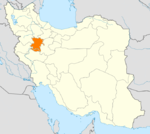- Asadabad, Iran
-
For the administrative subdivision, see Asadabad County.
Asadabad
اسدآباد— city — Coordinates: 34°46′57″N 48°07′07″E / 34.7825°N 48.11861°ECoordinates: 34°46′57″N 48°07′07″E / 34.7825°N 48.11861°E Country  Iran
IranProvince Hamadan County Asadabad Bakhsh Central Population (2006) - Total 51,304 Time zone IRST (UTC+3:30) - Summer (DST) IRDT (UTC+4:30) Asadabad (Persian: اسدآباد, also Romanized as Asadābād)[1] is a city in and capital of Asadabad County, Hamadan Province, Iran. At the 2006 census, its population was 51,304, in 12,583 families.[2]
Situation & History
It is known as the birth place of Seyyed Jamaleddin Asadabadi. It is the capital of Asadabad County.
The ethnic composition of Asadabad, similar to other cities in Hamadan province is of mixed ethnic groups, with Persian majority and Kurdish, Azeri, Lur and Lak minorities.
Based in western Iran, Hamadan is a green mountainous area on the foothills of the 3574 - meter Alvand Mountain. The city is 1850 meters above the sea level and is 375 kilometers from the capital Tehran, 190 km east of Kermanshah and 530 km north west of Isfahan. It is the oldest Iranian city and one of the oldest in the world. At the Media era, the dawn of Iranian history, the city was called Hegmataaneh. In Greek documents, however; the city was named Ekbaataan. The valley of Hegmataaneh in the city contains a lot of the relics of Media, Achaemenid, Sassanidae and Islamic era civilizations. Some of the relics have been uncovered and are on display to the interested. All this indicates that Hamadan has a huge share in the establishment of the human civilization.
The poet Ferdowsi says that Ecbatana was built by King Jamshid. The modern Hamadan consists of a large central roundabout with six avenues running into it.
While lacking antique vestiges, Hamadan, has several monuments worthy of interest. They are usually mausoleums. Their exterior was recently renewed by constructions inspired by the spindle - shaped structure of Mongol towers, to the exclusion of all other features of these towers. The best one covers the Tomb of the famous Ibn Sina called Abu Ali by the Persians and Avicenna by the Western world.
- Baba Tahir Oryan - Born in Hamadan, Iran, in the early eleventh century, was considered by his contemporaries as one of the most eminent, erudite mystics and sentimentalists of his time, a reputation he has held in the affection of his countrymen to the present day.
- Ganjnameh - The Achaemenian treasure inventory - Abbas-Abad Valley, 5 km West of Hamadan. Two inscriptions carved on the face of Alvand mountain, belonging to Darius and Xerxes [Khashayarshah].
- Abu Ali Sina (Avicenna): A Great Persian Mathematician, Physician, Phylosopher and Scientist
Born: 980 in Kharmaithen (near Bukhara, Turkistan), Central Asia (now Uzbekistan) Died: June 1037 in Hamadan,Iran.
- Hamadan Rugs
- Mausoleum of Esther - An Achaemenian Queen
A Complete list of the monuments of Hamadan are as follows: Stone Lion: It is the statue of a lion, which was carved out in the Arsacian era, but has now lost the original appearance. The statue is a symbol of the city of Hamadan.
Ganjnaameh Tabloids: The two tabloids are written in cuneiform and ancient Persian language. They have been engraved on Alvand Mountain, at the extreme end of the beautiful valley of Abbaas Abad. The tabloids ordered carved by Darius the Great and Xerxes, carry the two supplications of Ahura Mazda and the prayer for the preservation of the country.
Alavian Cupola: It is the most important work of the Islamic era in Hamadan. The brick-made monument was set up during the Seleucid era and has nice plaster-works. The compound is home to the tombs of two Alavis.
Astaru Mardkhai Tomb: It is the tomb of the Jewish wife of Xexes. The name of Astaru has been mentioned in the Bible. The building is very simple, but there are some coffins on the graves, which have been professionally crafted. A copy of the Old Testament is also kept at the place. There are some tabloids engraved as stucco on the inside wall in Hebrew.
Tomb of Abu Ali Sina: The renowned Iranian scientist, physician and philosopher has been buried in Hamadan and has a nice tomb which was set up in 1954. The tomb of Aaref, the early 20 century Iranian poet lies near that of Ibne Sina.
The Tomb of Baabaa Taher Oryaan:Surrounded by a beautiful garden, the tomb of Baabaa Taher Oryaan, the mystic Iranian poet, is located in Hamadan.
Caves: Due to its geographical position, Hamadan has a lot of caves, the longest and most wonderful of them Ali Sadr, which is 60 kilometers long. The cave of Ali Sadr contains several lakes, halls and corridors. In some parts, the height of the cave reaches 40 meters. The cave enjoys a lighting system, and one can go through the cave by recreational boats with the guide.
References
- ^ Asadabad, Iran can be found at GEOnet Names Server, at this link, by opening the Advanced Search box, entering "-3053792" in the "Unique Feature Id" form, and clicking on "Search Database".
- ^ "Census of the Islamic Republic of Iran, 1385 (2006)" (Excel). Islamic Republic of Iran. http://www.amar.org.ir/DesktopModules/FTPManager/upload/upload2360/newjkh/newjkh/13.xls.
Capital Hamadan
Counties and Cities AsadabadFamenin CountyFameninKabudarahang CountyKabudarahang · Gol Tappeh · Shirin SuSights Ganjnameh • Shrine of Habakkuk,Toyserkan • Hamedan Stone Lion • Ali Sadr Cave • Hamedan Museum of Natural History • Noshijan fire temple,Malayer • Shrine of Esther and Mordechai,Hamedan • Baba Taher Mausleum,Hamedan • Avicenna mausoleum,Hamedan • Emamzadeh Yahya,Hamedan • Alvand ski resort • Pirsolayman lagoon • Median capital of Hegmataneh,Hamedan • Ecbatan dam • Geyan lagoon • Baba-pireh shrine • Ecbatana •Categories:- Asadabad County
- Cities in Iran
- Cities in Hamadan Province
- Iran geography stubs
Wikimedia Foundation. 2010.

